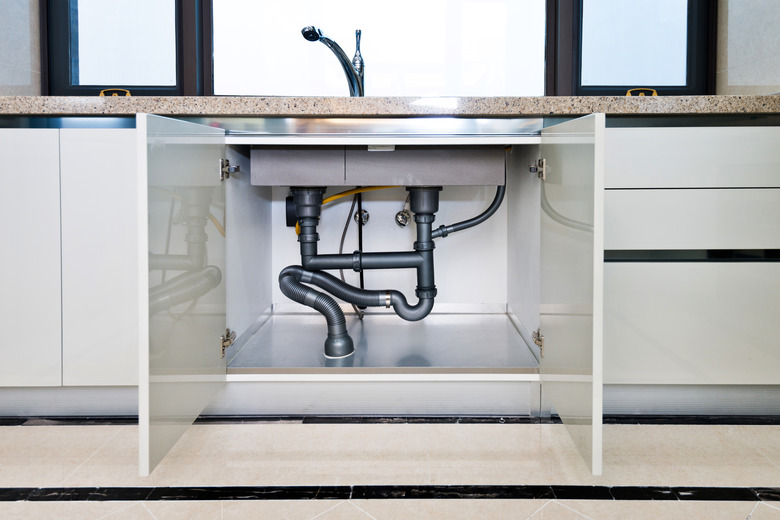How To Close Openings Around Pipes Under A Kitchen Sink
Plumbers aren't finish carpenters or painters. It isn't their job to worry about appearances, and nowhere is this more apparent than under a sink. It's common for plumbers to create large, rough-cut holes for water and rain pipes and to leave them unfilled. Because the holes are out of sight under the sink, many homeowners forget they are even there.
Mice, rats and bugs of all persuasions know about them, though, and they use them as doorways into your house. Cold air can also enter through these holes and frustrate your efforts to insulate your kitchen and reduce your energy consumption. Be frustrated no more — filling gaps around copper pipes and plastic drain pipes is a fast and easy project.
Use Spray Foam Around Pipes
Use Spray Foam Around Pipes
Pretty Handy Girl recommends Great Stuff for sealing gaps around pipes. Even though her post is sponsored by Great Stuff, it's still great advice. You don't have to use Great Stuff of course, because other brands, such as Loctite Tite Foam, are just as good. Most spray foams are essentially liquefied polyurethane, which expands into a hardening foam that completely fills gaps up to 2 inches wide and sometimes more.
Polyurethane is an inert material that has little to no environmental impact, and it adheres permanently. The hardened foam provides thermal insulation, and it's impervious to pests. Rodents can't chew their way through it, and when applied correctly it leaves no gaps for insects.
If you want to be certain that the foam will keep out pests, you can opt for Great Stuff Pestblock Insulating Foam, but it doesn't contain any pesticides. A quick perusal of the Safety Data Sheets of this product and that of Great Stuff Gaps & Cracks Insulating Foam shows that both contain essentially the same ingredients. Since the Pestblock foam costs twice as much as the original, you might as well opt for the latter and save the money.
How to Use Spray Foam
How to Use Spray Foam
Spray foam is easy to use, but caution is required because it sticks to everything and is difficult, if not impossible, to remove. Solvents won't dissolve it, and if you get it on your hands, clothing or the sink cabinet, mechanical removal is required. You can't always remove it from fabric, so wear old or disposable clothing when using it.
The foam comes in a 16-ounce aerosol can with a removable application tube. Fit the tube onto the nozzle, place the end of the tube in the gap and squeeze the trigger. Fill gaps about halfway, and the foam will expand to complete the job. Keep a rag handy and cover the end of the tube as soon as you're done spraying to avoid dripping any liquid onto the bottom of the cabinet.
Other Ways to Fill Gaps
Other Ways to Fill Gaps
If the pipes under your kitchen sink are exposed, you may not want to fill the gaps around them with spray foam, which isn't the most attractive material in the world. You can use caulk to fill gaps less than about 1/2 inch wide, and you can fill wider gaps by stuffing them with steel wool and caulking over it.
Another even more appealing method for patching drywall around pipes is to fill the gaps with patching compound, which is a powder that sets rock hard when you mix it with water. Trowel in the compound, give it an hour to set and then apply a coat of drywall joint compound, which is easier to sand flat. Finish up with a coat of paint to make the gaps disappear.
